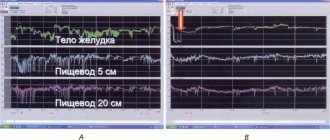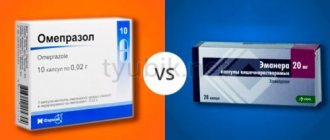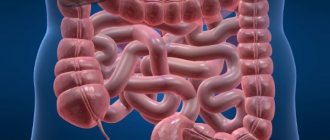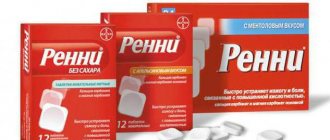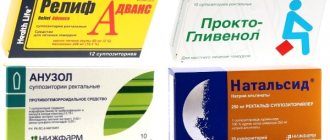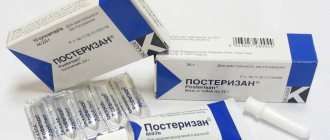Ranitidine ~ H2-histamine receptor blocker
The product is not available in the presented pharmacies*
II generation H2-histamine receptor blocker. The mechanism of action is associated with the blockade of H2-histamine receptors in the membranes of parietal cells of the gastric mucosa. Suppresses daytime and nighttime HCl secretion, as well as basal and stimulated, reduces the volume of gastric juice caused by gastric distension with food load, the action of hormones and biogenic stimulants (gastrin, histamine, acetylcholine, pentagastrin, caffeine). Reduces the amount of HCl in gastric juice, practically without suppressing “liver” enzymes associated with cytochrome P450, and does not affect the concentration of gastrin in plasma or mucus production. Reduces pepsin activity. More about the drug »
ATTENTION! ALWAYS check with your doctor or pharmacist to see if the found analogue can serve as a full replacement for the drug prescribed to you or the drug you are looking for. This is due to the need to use the dosage forms and doses prescribed specifically for you, which may differ even among analogues (more about analogues of drugs).
pharmachologic effect
Ranitidine is an antiulcer drug, the active substance of which belongs to the group of histamine H2 receptor antagonists. The principle of action is based on blocking H2 receptors in parietal cells located in the gastric mucosa, as well as on inhibiting the production of hydrochloric acid. Under the influence of the active substance, the volume of total secretion decreases, suppressing the activity of pepsin in gastric juice.
Thanks to the antisecretory effect of Ranitidine, it is possible to create favorable conditions for the healing of ulcerative lesions in the digestive tract (stomach, duodenum). The active substance is capable of exerting a protective effect by enhancing reparative processes, increasing the secretion of special mucous substances, and improving microcirculation.
Ranitidine or Omeprazole – which is better for gastritis
Omeprazole is an active substance from the group of proton pump inhibitors that blocks the production of hydrochloric acid and neutralizes its excess. Used to treat gastritis and ulcers, relieve heartburn symptoms, and prevent the negative effects of NSAIDs. Available in enteric capsules from various manufacturers:
- Omeprazole (Russia);
- Omez (India);
- Losek Maps (Sweden);
- Gastrozol (Russia);
- Omeprazole-Teva (Israel);
- Orthanol (Slovenia);
- Ultop (Slovenia).
Ranitidine is a predominantly Russian drug that blocks H2 receptors. Reduces the production of hydrochloric acid, but does not neutralize the excess substance. Available in tablets for children over 12 years of age and adults.
Which is better, Ranitidine or Omeprazole, depends on the indications, the patient’s condition, and age characteristics. Cases of resistance to omeprazole have been reported, in which case the first medication or other substitutes are indicated. In general, the analogue Omeprazole is more effective and more modern, and is less likely to cause increased production of hydrochloric acid after stopping taking the drug.
Pharmacodynamics and pharmacokinetics
The active substance ranitidine is absorbed quite quickly from the lumen of the digestive tract. Food has no effect on the degree of absorption. Bioavailability reaches 50%. Peak concentrations are recorded within 2-3 hours after oral administration. 15% bound to plasma proteins. Partial metabolism takes place in the hepatic system with the formation of ranitidine S-oxide and desmethylranitidine.
The drug is characterized by a “first pass” effect through the hepatic system. The condition of the liver affects the extent and rate of elimination. After oral administration, the half-life is 2.5 hours, and with a creatinine clearance of 20-30 ml/min, this figure increases to 8-9 hours.
A small amount is excreted in the feces, the main part is excreted unchanged through the renal system. The active component does not pass the blood-brain barrier well, but penetrates the placenta well. Ranitidine is released during lactation.
Ranitidine or Famotidine
Ranitidine and Famotidine are identical drugs from the group of n2-cholinergic receptor blockers. They differ in active ingredient, price and manufacturer. They provide the same therapeutic effects - reducing the secretion of hydrochloric acid, healing ulcers and erosions.
The drugs Ranitidine and Famotidine are characterized by general indications, prescription restrictions, and side effects. The choice of medication is at the discretion of the doctor.
Indications for use of Ranitidine
What do Ranitidine tablets help with?
The main area of application of the drug is gastroenterology. The drug is prescribed for the treatment of various ulcerative pathologies of the digestive system, and can also be used for prophylactic purposes.
- peptic ulcer of the stomach and duodenum;
- symptomatic ulcerative lesions of the digestive tract;
- Zollinger-Ellison syndrome;
- gastroesophageal reflux disease (GERD);
- erosive esophagitis;
- prevention of aspiration of gastric juice during surgical interventions with the introduction of anesthesia;
- prevention of the development of “stress” ulcers;
- prevention of the development of ulcerative lesions of the gastrointestinal tract after surgical interventions;
- prevention of recurrent bleeding from the upper digestive tract.
Ranitidine or Omez – which is better for heartburn?
Omez is an analogue of Ranitidine with the main component omeprazole. The drug belongs to the group of proton pump inhibitors and is prescribed for heartburn caused by increased secretion of hydrochloric acid.
For heartburn, the analogue can be used once or in a course. Ranitidine is prescribed for the same purpose and is available without a doctor's prescription. The disadvantage is that the body quickly gets used to it and the initial doses are ineffective, and the need to increase the number of tablets taken. Suitable for people with swallowing difficulties.
Which is better, Ranitidine or Omez, depends on the severity of the condition and the characteristics of the patient.
Side effects
Hematopoietic system:
- leukopenia (with long-term therapy);
- thrombocytopenia.
The cardiovascular system:
- development of atrioventricular block (rarely, mainly with intravenous infusion).
Digestive tract:
- stool disorders ( constipation / diarrhea syndrome );
- hepatitis (extremely rare).
Side effects from the central nervous system:
- vertigo , dizziness ;
- fast fatiguability;
- blurred visual perception;
- headache;
- hallucinations (extremely rare);
- confusion (extremely rare).
Endocrine system, metabolism:
- increased prolactin ;
- increased creatinine ;
- amenorrhea;
- gynecomastia;
- decreased libido;
- impotence.
Other reactions:
- recurrent mumps ;
- arterial hypotension;
- bronchospasm;
- arthralgia;
- hair loss;
- anaphylactic shock;
- angioedema;
- hives;
- various rashes on the skin;
- myalgia.
Ranitidine tablets, instructions for use (Method and dosage)
The treatment regimen is selected individually. The tablets are intended to be taken orally.
The daily dosage is 300-450 mg (can be increased to 600-900 mg if necessary), divided into 2-3 doses. To prevent exacerbation of diseases of the digestive tract, the drug is prescribed at bedtime at a dose of 150 mg. The duration of therapy is determined by the dynamics of the disease.
For pathology of the renal system, the medication is prescribed twice a day at a dose of 75 mg.
Your doctor will tell you how long you can take the pills; on average, the course of treatment lasts 2-4 weeks.
Ranitidine 75 mg as an over-the-counter drug
Histamine receptor type 2 (H2 receptor), found on the parietal cell of the gastric mucosa, plays a critical role in stimulating acid production by this cell. The experiment showed that the first synthesized H2 receptor antagonist, burimamide (JW Black et al., 1972), reduces histamine-induced acid secretion. Less than 10 years remained before the triumphant appearance of ranitidine in 1981, one of the most famous drugs in the world and in human history. Since 1988, omeprazole and other proton pump inhibitors began to replace H2 receptor blockers, and at present it is proton pump inhibitors that are considered the most powerful and promising agents in the treatment of acid-related diseases. The place of ranitidine in clinical practice has been re-evaluated. So, on the one hand, its antisecretory effect is inferior to proton pump inhibitors, but, on the other hand, this antisecretory effect has been objectively proven in numerous clinical studies in different patient populations, and, in addition, this drug has demonstrated high safety of use. There are few drugs that have undergone such detailed study and have such a complete information base on their use.
Data on the safety of ranitidine were analyzed and summarized based on the results of 189 (!) clinical studies conducted in 1979–1992. (JG Mills et al., 1997). The total number of patients was 31,203 people. Almost half of the studies were placebo-controlled, and half had a duration of more than 4 months. Depending on the indications, ranitidine doses ranged from 75 to 1200 mg/day. Adverse events (any unexpected symptoms or events that occurred in a patient with or without such a connection with the drug) were reported in 20% of patients receiving ranitidine; while in the group receiving placebo, adverse events occurred in 27%. It is very interesting that there is no connection between the dose of ranitidine and the frequency of adverse events: the percentage of patients with adverse events was compared when taking 150 mg (n = 4466), 300 mg (n = 17793), 600 mg (n = 2186), 1200 mg ranitidine ( n = 1708) and placebo (n = 5670). Despite an eightfold increase in the daily dose from 150 to 1200 mg, the frequency of adverse events did not change and fluctuated around 20%.
The global adverse event database contains 9362 such reports for ranitidine, representing an adverse event rate of 102 per 1,000,000 ranitidine exposures (JG Mills et al., 1997). It is in the reports of adverse events that contain information about possible episodes of gynecomastia, hyperprolactinemia and impotence. But when calculating the frequency of these adverse events (0.2–1.3 cases per 1,000,000), it does not differ from the population one. In a post-marketing population-based cohort study specially organized in the UK, it was proven that the use of antisecretory drugs (H2 blockers and proton pump inhibitors) is not associated with the risk of gynecomastia in men (LA Garcia-Rodrigues, H. Jick, 1994).
OTC drug
Ranitidine has received a new place in clinical practice, despite the fact that it has lost its leading position to proton pump inhibitors in the recommendations and standards for the treatment of acid-related diseases. Recommendations and standards regulate doctor's prescriptions and largely relate to prescription drugs. Ranitidine in many countries has received registration as an over-the-counter drug, i.e. it has become more accessible to the population, taking into account the possibility of excluding the first link from the “doctor-pharmacist-patient” chain. As an OTC (over-the-counter) drug, ranitidine is also available in Russia, in particular ranisan, produced by the company PRO.MED.CS. Prague as
Demand
What are the requirements for an over-the-counter drug? An over-the-counter product should be absolutely effective. It must be in demand, i.e. effective in individuals with symptoms that are common in the population and well studied in terms of pathogenesis and prognosis. It must be safe, and this quality is as important as its effectiveness. Taking this medication should be simple, so that the patient can independently fully understand the frequency and mode of its use.
Ranisan (ranitidine) at a dose of 75 mg as an over-the-counter drug is recommended primarily in the presence of episodic heartburn. Let's look at what this symptom is and how often it occurs. It is assumed that heartburn occurs when the nerve endings in the mucous membrane of the esophagus are irritated in response to the aggressive action of acidic contents refluxed from the stomach (a consequence of gastroesophageal reflux). According to the results of a population-based study conducted in Novosibirsk within the framework of the WHO program “Monitoring morbidity and mortality from cardiovascular diseases and the levels of their risk factors,” it turned out that 48.5% of women and 51.4% of men experience episodic heartburn and often complain of heartburn in 3.7% of women and 1.2% of men (S. A. Kurilovich, V. O. Reshetinkov, 2000). One cannot but be concerned about the fact that among Novosibirsk teenagers (14-17 years old), heartburn with a frequency of more than 1 time per month was recorded in 16.9% of respondents, more than 1 time per week - in 6.7% of respondents (O. V Reshetnikov et al., 2002). Such a high frequency of heartburn is typical, according to domestic authors, for the populations of the European part of Russia and the regions of Siberia. Data on the incidence of heartburn in the United States and Western European countries also exceed 30% of the population.
Thus, heartburn is one of the most common symptoms that occurs in almost all age groups. In cases where heartburn occurs almost daily, against the background of erosive esophagitis or non-erosive reflux disease of the esophagus, which is difficult for patients to tolerate, the prescription of proton pump inhibitors is required. But in the presence of rare, episodic heartburn (and the number of such people in the population is also large), the use of ranitidine is possible. If the patient did consult a doctor about rare heartburn, he underwent an endoscopic examination, and if no erosions were found in the esophagus, ranitidine was considered an adequate treatment choice. So, ranitidine as an over-the-counter drug is a sought-after drug because it targets the widespread symptom of episodic heartburn, which may be a manifestation of minimally severe esophageal reflux disease, or perhaps simply a consequence of overeating or eating foods that provoke heartburn.
Efficiency
Having spoken about the demand for the OTC drug ranitidine, let’s consider the question of its effectiveness. A randomized, double-blind study was undertaken in adults with heartburn duration of at least 3 months (AA Ciociola et al., 2001). Patients were divided into ranitidine 75 mg (n = 537), ranitidine 25 mg (n = 539), and placebo (n = 544). Patients were recommended to take tablets to relieve heartburn on demand (but not more than 4 pieces per day) for 2 weeks. It was shown that ranitidine 75 mg and 25 mg, when taken as needed, was significantly more effective than placebo in relieving heartburn (p < 0.05), and mild, moderate and severe heartburn disappeared equally when taking an H2-receptor blocker. Nocturnal heartburn episodes were better controlled with the 75 mg dose than with the 25 mg dose.
A study was undertaken to show the possibility of preventing heartburn after a known food trigger (KA Pappa et al., 1999). During the first visit, patients were given a standard breakfast (chili, chips and a soft drink) and a placebo half an hour before. If heartburn occurred, its severity was assessed, and patients (n = 248) were randomly assigned to two groups: before the second test breakfast (after 4-14 days), patients in one group were given ranitidine 75 mg, in the other group - placebo. Over a period of 4.5 hours, patients assessed the severity of heartburn at 15-minute intervals using a visual analogue scale. Ranitidine was significantly more likely to prevent heartburn completely compared to placebo (p < 0.006); in addition, the severity of heartburn, if it did occur, was less with ranitidine than with placebo (p < 0.001).
As noted above, ranitidine is used as an over-the-counter drug in a dose of 75 mg. This dose is less than the 150 or 300 mg of “prescription” ranitidine that doctors are used to. Does reducing the dose affect the effectiveness of the drug? JS Cohen (2003) analyzed this issue as the title of his article, “Why have lower, more effective doses of over-the-counter drugs not been used as prescription drugs before?” There is strong evidence that lower doses of OTC drugs are adequately effective, not only ranitidine and famotidine, but also some anti-inflammatory and antihistamine drugs. The author concludes that drug doses registered for over-the-counter use are effective for most patients with moderate symptoms and for some patients with severe symptoms. During the initial registration of drugs, a higher dose appears, primarily because new drugs are being studied in more severe categories of patients. Manufacturers and healthcare providers are also aiming to register average doses of drugs.
Safety
A huge amount of factual material has been collected on the safety of ranitidine, and this issue has already been discussed in this article. The above data were obtained primarily from a prescription drug study. A new stage in studying the safety of ranitidine is associated with its over-the-counter use. Thus, M. Andersen and JS Schou (1991), representing the Danish Committee on Adverse Drug Events, reported that one year after the introduction of over-the-counter cimetidine and ranitidine, there were no reports of adverse reactions associated with ranitidine throughout the country, and only one report of cimetidine. The already cited review by JG Mills et al (1997) summarized data from three double-blind, placebo-controlled studies with doses of ranitidine registered for over-the-counter use. In these studies, on-demand ranitidine was used for the treatment of heartburn at different doses (25, 75, and 125 mg—maximum 4 tablets per day for 7–14 days). Adverse events were reported in 26% of patients receiving 25 mg, 25% of patients receiving 75 mg, 29% receiving 125 mg, and 26% of patients receiving placebo. There was no statistically significant difference in the distribution of adverse events by organs and systems in different treatment groups (Table). The most common adverse events were the same in range and frequency as in the prescription drug studies.
These data once again indicate that high safety makes ranitidine an effective over-the-counter drug.
Availability of information
An important point when deciding whether to take an over-the-counter drug is the availability of information in the package insert for the patient, who must independently understand the indications, contraindications and procedure for taking it. A special study was undertaken in the USA. The study involved 1405 adults who took ranitidine 75 mg for episodic heartburn (AA Ciociola, MA Sirgo, KA Pappa). They received no explanation or instructions other than the contents of the package insert. While taking ranitidine, patients kept a special diary, and only after the end of the treatment course the doctor questioned the patient, took an anamnesis, took into account the amount of the drug taken and assessed its use and safety. At least 84% of people participating in the study clearly understood the instructions regarding the maximum dose of the drug and the maximum duration of its use. 90% of patients strictly adhered to the recommendation to take only 1 tablet and not exceed a maximum of 2 tablets per day. 96% of subjects strictly adhered to the instructions not to take the maximum dose for more than 14 days. So, the vast majority of study participants, without additional advice from a doctor or pharmacist, only thanks to the information in the package insert, followed the correct regimen for using OTC ranitidine at a dosage of 75 mg, without violating the recommendations for the maximum dose and duration of treatment.
Thus, ranitidine (Ranisan) at a dosage of 75 mg as an over-the-counter drug for the treatment of episodic heartburn is in demand due to the high frequency of this symptom in the population and its frequent “subtherapeutic severity.” The effectiveness and safety of this drug determine its choice for patients who occasionally experience heartburn.
Literature
- Kurilovich S. A., Reshetinkov V. O. Epidemiology of diseases of the digestive system in Western Siberia. Novosibirsk, 2000. P. 165.
- Reshetnikov O.V., Kurilovich S.A., Tereshenok I.N. et al. Dyspepsia and gastroesophageal reflux in adolescents // Therapeutic archive. 2002. No. 2. P. 9–13.
- Andersen M., Schou JS Adverse reactions to H2-receptor antagonists in Denmark before andafter transfer of cimetidine and ranitidine to over-the-counter status//Pharmacol. Toxicol. 1991; 69: 253–258.
- Ciociola AA, Pappa KA, Sirgo MA Nonprescription doses of ranitidine are effective in the relief of episodic heartburn//Am. J. Ther. 2001; 8:399–408.
- Ciociola AA, Sirgo MA, Pappa KA et al. A study of the nonprescription drug consumer`s understanding of the ranitidine product label and actual product usage patterns in the treatment of episodic heartburn//Am. J. Ther. 2001; 8:387–398.
- Cohen JS Why aren`t lower, effective, OTC doses available earlier by prescription?//Ann. Pharmacother. 2003; 37: 136–142.
- Garcia-Rodrigues LA, Jick H. Risk of gynecomastia associated with cimetidine, omeprazole, and other anti-ulcer drugs//Br. Med. J. 1994; 308:503–506.
- Mills JG, Koch KM, Webster C. The safety of the ranitidine in over a decade of use//Aliment. Pharmacol. Ther. 1997; 11: 129–137.
- Pappa KA, Williams BO, Pyane JE et al. A double-blind, placebo-controlled study of the efficacy and safety of non-prescription ranitidine 75 mg in the prevention of meal-induced heartburn//Aliment. Pharmacol. Ther. 1999; 13:467–473.
T. L. Lapina , Candidate of Medical Sciences, Associate Professor of MMA named after. I. M. Sechenova, Moscow
Overdose
Main manifestations:
- skin rashes;
- confusion;
- headache;
- dizziness;
- increased drowsiness.
First aid consists of taking enterosorbents ( Polysorb , Smecta , Activated Carbon and others) and calling an ambulance.
Interaction
There is a decrease in ranitidine absorption rates when treated with antacids.
Elderly patients experience deterioration in attention and memory while taking anticholinergic drugs.
It is assumed that medications that block histamine H2 receptors are able to suppress the ulcerogenic effect of drugs from the NSAID group on the gastric mucosa.
There is a decrease in the clearance of Warfarin during treatment with Ranitidine. Medical practice describes a case of bleeding and hypoprothrombinemia in a patient who was taking Warfarin.
There may be an undesirable increase in ranitidine absorption rates during simultaneous therapy with tripotassium bismuth dicitrate .
Cases of hypoglycemia when taking Glibenclamide .
Ranitidine inhibits the absorption of Itraconazole and Ketoconazole .
The half-life of Metoprolol and its AUC increase during treatment with Ranitidine.
Absorption of the drug changes when taking high doses of sucralfate (more than 2 g).
There is a slowdown in the excretion of Procainamide through the renal system, which leads to an increase in the concentration of the active substance in the blood.
The absorption of Triazolam increases, which is associated with a change in the pH of gastric juice.
The risk of toxicity increases with treatment with phenytoin , which is explained by a significant increase in its concentration in the blood.
There is an increase in the bioavailability of Furosemide with simultaneous therapy with Ranitidine.
In the medical literature there is a description of a case of the development of ventricular arrhythmia of the bigeminia in a patient who took Ranitidine and Quinidine .
When treated with cisapride, the risk of cardiotoxicity increases.
There is an increase in the level of Cyclosporine in the blood with parallel treatment with Ranitidine.
How to choose the right analogue?
Many patients try to select analogues of drugs prescribed by gastroenterologists. If they differ only in price and the active ingredients are similar, consulting a doctor is not necessary. If there is a difference in the active component, the effect on the body, or the risk of side effects, laboratory and instrumental testing is first carried out. Blood, urine, feces, and gastrointestinal morphology are examined.
If you change the drug without the recommendation of a gastroenterologist, negative reactions may occur not only for the gastrointestinal tract, but also for any part of the body.
For example, if a patient evaluates which is better, Ranitidine or Omeprazole, consultation with a doctor is required. The drugs contain different active ingredients that can cause negative effects. Many medications provoke neurological disorders, dysfunction of the gastrointestinal tract, genitourinary, and biliary systems. It will be necessary to additionally eliminate the negative disorders that have arisen.
If the substitute is chosen correctly, gastrointestinal function is normalized when using the first dose. The secretion of hydrochloric acid is reduced, the development of erosion and ulcers on the surface of the mucous membrane is prevented. Patients stop experiencing heartburn, which causes damage to the esophagus and stomach. Patients with peptic ulcer disease may experience remission, especially with the combined use of several prescribed drugs.
special instructions
In case of severe pathology of the renal system, the medication is prescribed with caution. Before using the drug, it is necessary to exclude oncological diseases of the intestines , esophagus and stomach .
Long-term therapy of weakened patients who are in a state of stress can provoke the development of bacterial disease of the stomach, as well as the subsequent spread of the inflammatory process.
If the medication is abruptly discontinued, the risk of relapse of peptic ulcer increases. Preventive therapy is more effective with a course of taking the drug for 45 days in the fall and spring, compared to continuous use.
In patients suffering from various rhythm disorders, rapid intravenous administration of the solution can provoke bradycardia .
For persons with of porphyria , Ranitidine is prescribed with caution due to the risk of developing an acute attack.
Distortion of laboratory test parameters (liver enzymes, creatinine, GGT) is allowed.
The time interval between taking antacids and Ranitidine should be at least 1-2 hours due to the risk of changes in the absorption of the active substance.
Clinical studies confirming the safety of the drug in pediatric practice are limited.
Ranitidine or De-Nol – which is better?
De-Nol is an imported analogue without side effects, sold freely from pharmacies based on bismuth salt. The medication combines several actions:
- protects the gastric mucosa;
- antiulcer;
- bactericidal against the causative agent of gastritis and peptic ulcer Helicobacter pylori;
- anti-inflammatory;
- astringent.
The analogue is applied over a course of 4–8 weeks. Combination with proton pump inhibitors (Omeprazole, Rabeprazole, Esomeprazole) and Ranitidine is possible.
Which is better depends on the indications and the severity of the condition. The analogue is safer and more effective.
Ranitidine is an antiulcer drug sold without a doctor's prescription. However, for timely treatment of gastritis and ulcers, it is advisable to visit a gastroenterologist, make an accurate diagnosis and undergo comprehensive treatment. One of the measures is taking Ranitidine or analogues.
Ranitidine analogs
Level 4 ATC code matches:
Gastrosidine
Gistak
Acylok
Cimetidine
Zantac
Kvamatel
Famotidine
Structural analogues:
- Zantac
- Gistak
- Acylok
- Ranisan
- Ranitidine hydrochloride
Reviews of Ranitidine
The drug allows you to quickly relieve pain in the epigastric region due to ulcerative pathology of the digestive tract, gastropathy by reducing the acidity of gastric juice. Reviews about Ranitidine are mostly positive, because... The drug is well tolerated, causing virtually no negative symptoms if the dosage regimen is followed. Among the advantages are the low cost of the tablets and the quick effect in relieving heartburn.
The medication can be used in emergency cases in case of errors in the diet to prevent exacerbation of gastritis and peptic ulcers .
The downside is that it is impossible to use the medication during pregnancy and lactation.
Ranitidine price, where to buy
The cost of tablets varies depending on the region of sale and pharmacy chain. The average price of Ranitidine 150 mg No. 20 in Ukraine is 20 hryvnia.
- Online pharmacies in UkraineUkraine
- Online pharmacies in KazakhstanKazakhstan
Pharmacy24
- Ranitidine 150 mg N30 tablets PrAT "Tekhnolog", Uman, Cherkasy region, Ukraine
18 UAH. order - Ranitidine 150 mg N20 tablets PrAT "Technolog", Uman, Cherkasy region, Ukraine
12 UAH order
- Ranitidine-Darnitsa 0.15g No. 10 tablets PrAT” Pharmaceutical company “Darnitsa”, Ukraine
8 UAH order
- Ranitidine-Darnitsa 0.15g N20 tablets PrAT” Pharmaceutical company “Darnitsa”, Ukraine
15 UAH order
PaniPharmacy
- Ranitidine tablets Ranitidine tablets 150 mg No. 20 Ukraine, Tekhnolog ChAO
13 UAH order
- Ranitidine tablets Ranitidine-Zdorovye Forte tablets. p/o 300 mg No. 20 Ukraine, Health LLC
28 UAH order
- Ranitidine tablets Ranitidine-Zdorovye Forte tablets. p/o 300 mg No. 10 Ukraine, Health LLC
15 UAH order
- Ranitidine tablets Ranitidine tablets. p/o 0.15g No. 20 Ukraine, Darnitsa ChAO
19 UAH order
- Ranitidine tablets Ranitidine tablets. p/o 0.15g No. 10 Ukraine, Health LLC
8 UAH order
show more
Compound
| Film-coated tablets | 1 table |
| active substance: | |
| ranitidine (as hydrochloride) | 150 mg |
| 300 mg | |
| excipients: MCC; corn starch; Kollidon VA-64; colloidal silicon dioxide; magnesium stearate; hypromellose; ethylcellulose; polyethylene glycol 6000; propylene glycol; sodium lauryl sulfate; titanium dioxide; dye “Sunset” yellow |
